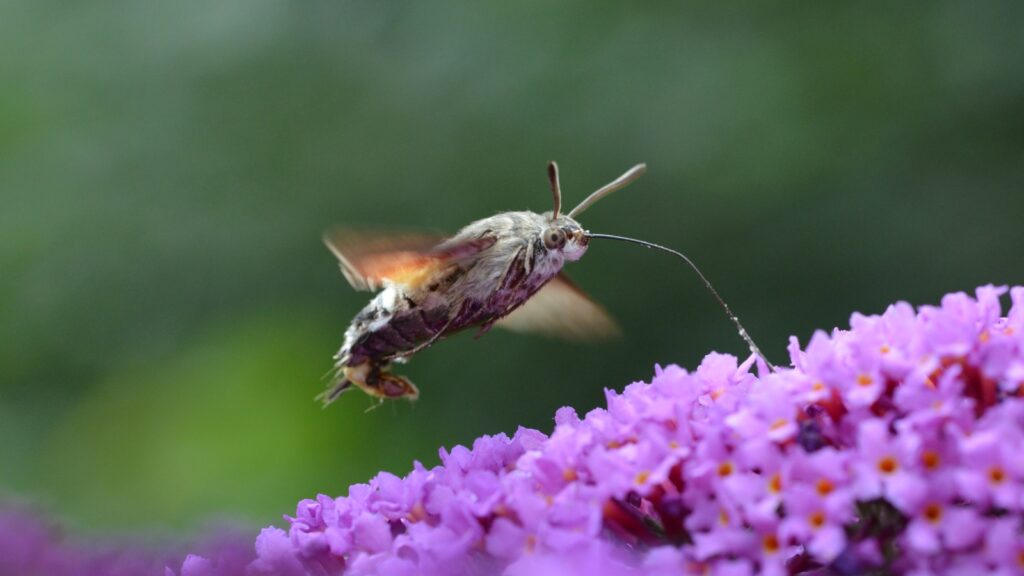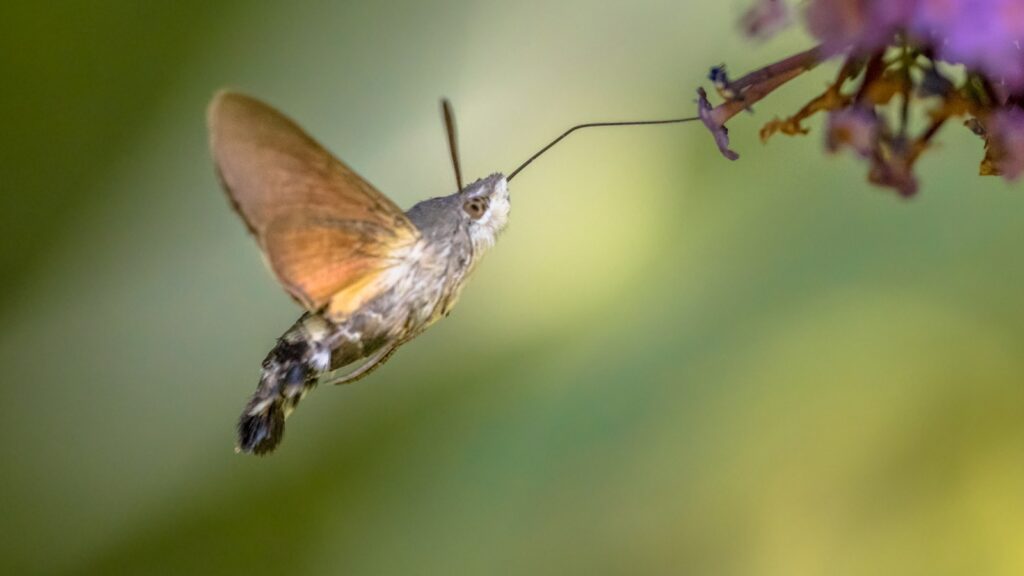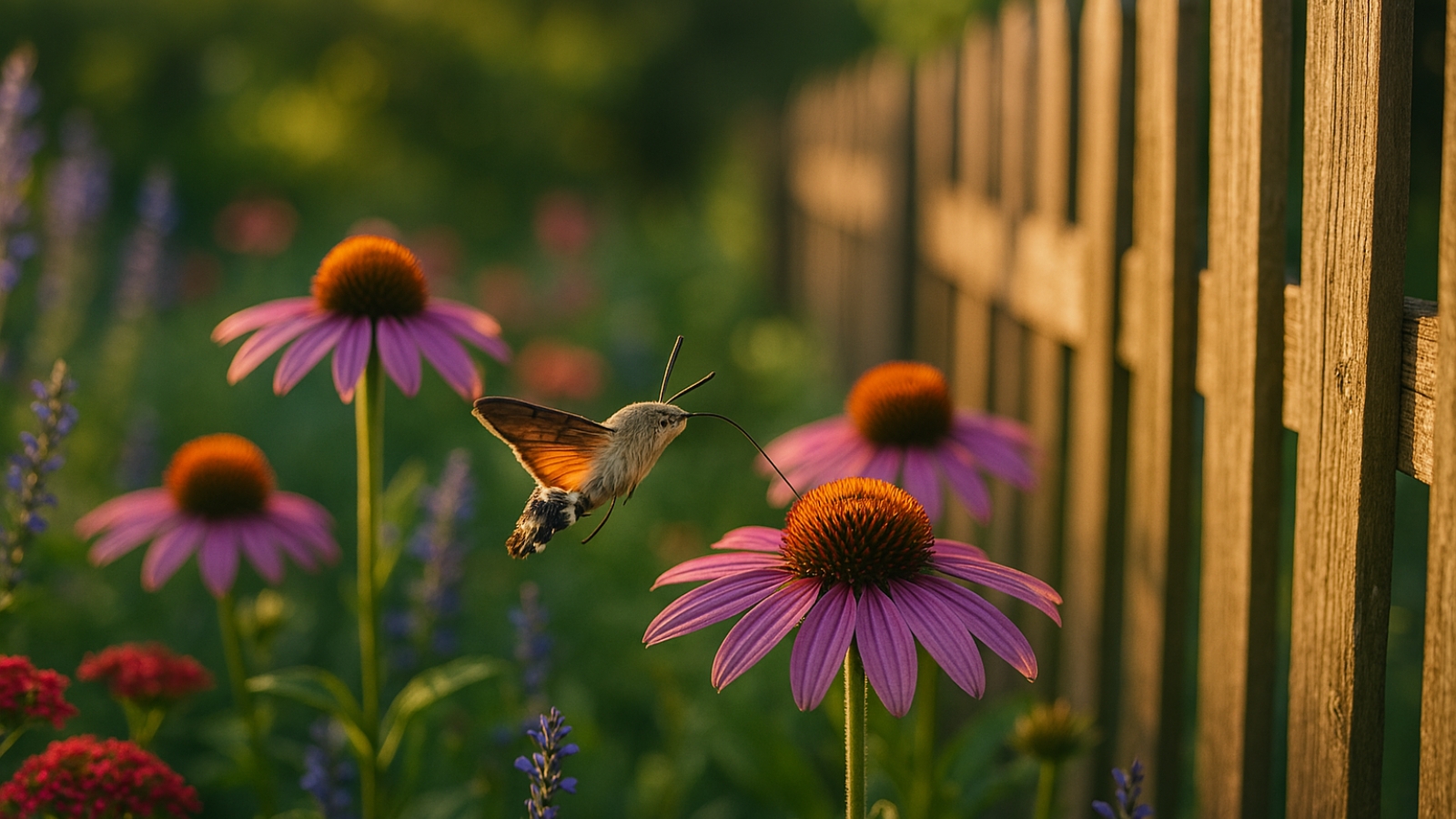Hummingbird hawk moths are not dangerous to humans or animals. These intriguing insects don’t bite, sting, or transmit diseases. While their caterpillars feed on certain plants like bedstraw and can be considered mild garden pests, adult moths are beneficial pollinators that pose absolutely no threat to people or pets.
Their remarkable resemblance to hummingbirds is simply a case of convergent evolution rather than any indication of danger.
Spotting a hummingbird hawk moth in your garden might leave you wondering if this unusual creature is safe to be around. With their distinctive hovering flight and long proboscis, these moths create quite a stir when they appear, often being mistaken for actual hummingbirds!
In this blog post, we’ll explore seven essential facts about hummingbird hawk moths and their safety, helping you understand why these remarkable insects are actually welcomed visitors to gardens.
What Exactly Are Hummingbird Hawk Moths?
Hummingbird hawk moths (Macroglossum stellatarum) belong to the Sphingidae family of moths. These remarkable insects have evolved to feed while hovering in front of flowers, using their extremely long proboscis (tongue) to reach deep into blooms for nectar.
These moths are true masters of flight, capable of maintaining a stationary hovering position just like their namesake, the hummingbird. They’re active during daylight hours, which is unusual for moths, and can be seen from spring through autumn in gardens, meadows, and woodland edges.
Their distinctive orange-brown hindwings flash during flight, and they have a chunky, furry body with a wingspanof about 5-7 cm. Unlike many moths, they don’t rest while feeding but instead keep their wings beating at an impressive rate of about 80 beats per second!

1. Hummingbird Hawk Moths Don’t Bite or Sting
Perhaps the most important fact for anyone concerned about safety is that hummingbird hawk moths have no physical capabilities to harm humans. They don’t have:
- Stingers
- Fangs or biting mouthparts
- Venom or poison glands
- Any aggressive behaviours.
Their mouthparts are specifically evolved for one purpose only: sipping nectar from flowers. The long, straw-like proboscis they extend while feeding is completely harmless and cannot penetrate human skin. Unlike some insects that might land on you and bite, these moths rarely even land on people, preferring to stay near their food sources.
2. Their Caterpillars Are Harmless to Humans
The caterpillar stage of the hummingbird hawk moth is equally harmless to people. Unlike some caterpillar species that have irritating hairs or spines that can cause skin reactions, hummingbird hawk moth caterpillars have smooth skin that poses no risk to humans.
These green or brownish caterpillars feature a distinctive horn at their rear end (a common feature among hawk moth species), but this horn is soft and not capable of stinging or injuring people. They’re typically found on their food plants like lady’s bedstraw, hedge bedstraw, or wild madder, and won’t venture onto humans or try to defend themselves against people.
3. They Don’t Damage Property or Structures
Unlike some pest insects that might damage your home or belongings, hummingbird hawk moths have no interest in:
- Wood or building materials
- Fabric or clothing
- Stored food products
- Furniture.
Adult moths feed exclusively on flower nectar, while their caterpillars eat only specific plants. This means your home, garden structures, and personal belongings are completely safe from these insects.
4. They’re Actually Beneficial Pollinators
Far from being dangerous, hummingbird hawk moths provide valuable ecosystem services as pollinators. As they hover in front of flowers to feed, they transfer pollen between blooms, helping plants reproduce. In addition to their role as pollinators, hummingbird hawk moths contribute to the overall health of their habitats by supporting plant diversity. Interestingly, while these moths are known for their impressive hovering abilities, many might be curious about hummingbird nest reuse facts, which reveal that some hummingbirds will return to previously used nests in subsequent breeding seasons. This behavior not only highlights the adaptability of these birds but also emphasizes the importance of preserving environments where both hummingbirds and moths can thrive.
Their ability to hover allows them to access flowers that other insects might not reach, and their long proboscis enables them to pollinate deep tubular flowers. Some flowering plants even depend on moths like these for successful pollination.
By supporting plant reproduction, these moths indirectly support the entire food web in your garden, making them valuable allies rather than pests to fear.
5. Their Garden Impact Is Minimal
While the caterpillars do feed on certain plants, their impact is typically quite limited and rarely causes significant damage to garden plants. The larvae primarily feed on:
- Bedstraws (Galium species)
- Wild madder
- Some related plants in the Rubiaceae family.
Most gardeners never even notice caterpillar feeding damage, as these insects don’t occur in large numbers and their preferred food plants are often wild species rather than prized garden specimens.
Compare this to genuinely destructive garden pests that might defoliate entire plants or trees, and it’s clear that hummingbird hawk moths are of little concern.
| Aspect | Hummingbird Hawk Moth | Genuinely Destructive Pests |
|---|---|---|
| Biting/Stinging | None | Some may bite or sting |
| Plant damage | Minimal, specific plants | Often widespread damage |
| Disease transmission | None | Some carry plant diseases |
| Control needed | Not necessary | Often requires intervention |
| Benefit to garden | Pollination | Little to none |

6. They Don’t Transmit Diseases
Some insects can pose indirect dangers by transmitting diseases to humans or pets. Mosquitoes, ticks, and certain flies are notorious for spreading pathogens that can cause serious illness. Hummingbird hawk moths, however, don’t:
- Bite humans or animals
- Feed on blood
- Pick up or transmit pathogens
- Spread any known diseases.
This makes them completely safe from a public health perspective. You can enjoy watching these fascinating creatures without any concern about disease transmission.
7. Their Unusual Appearance Is Just Mimicry
The reason hummingbird hawk moths look so similar to hummingbirds is due to a fascinating evolutionary process called convergent evolution. Both creatures independently evolved similar traits because these adaptations work well for nectar feeding.
This mimicry doesn’t indicate any danger – quite the opposite. By resembling birds, these moths may gain some protection from predators who might otherwise eat them.
Their bird-like appearance and behaviour might startle humans at first glance, but it’s simply a remarkable case of evolution rather than a warning sign of any danger.
Final Thoughts
Hummingbird hawk moths represent one of nature’s most fascinating examples of convergent evolution, where an insect has developed remarkably bird-like characteristics. Far from being dangerous, these gentle pollinators are completely harmless to humans, pets, and property, making valuable contributions to garden ecosystems through their pollination services.
If you’re lucky enough to spot one of these amazing insects in your garden, take a moment to appreciate its incredible hovering abilities and specialised feeding adaptations. Consider planting nectar-rich flowers like phlox, verbena, or buddleia to attract more of these beneficial visitors to your outdoor space.
Have you ever spotted a hummingbird hawk moth in your garden? What was your first impression when you saw one hovering among your flowers? Share your experiences in the comments below!
If you found this article helpful, please share it with fellow garden enthusiasts who might be curious about these fascinating creatures.
Frequently Asked Questions
Q: Are baby hummingbird hawk moths (caterpillars) dangerous?
A: No, hummingbird hawk moth caterpillars are completely harmless to humans and pets. Unlike some caterpillar species, they don’t have irritating hairs or spines that could cause skin reactions. Their horn-like projection at the rear end looks intimidating but is soft and cannot sting or puncture skin.
Q: Can hummingbird hawk moths damage my garden plants?
A: The impact of hummingbird hawk moths on garden plants is minimal. While their caterpillars do feed on plants in the bedstraw family (Galium species), they rarely cause significant damage. The adult moths are actually beneficial as they help pollinate flowers while feeding on nectar.
Q: Do hummingbird hawk moths come into houses?
A: Hummingbird hawk moths rarely enter houses. They’re primarily interested in nectar from flowers and have no reason to come indoors. If one does accidentally fly in, it will typically try to find its way out again and can be gently guided toward an open window or door.
Q: How can I tell the difference between a hummingbird hawk moth and an actual hummingbird?
A: The key differences are size and features. Hummingbird hawk moths are smaller (wingspan around 5-7 cm) than most hummingbirds and have antennae. They also have a furry, moth-like body rather than feathers, and orange-brown hindwings that flash during flight.
Q: Do hummingbird hawk moths sting like wasps or bees?
A: No, hummingbird hawk moths cannot sting. They don’t have a stinger or any defensive mechanisms that could harm humans or animals. Their long proboscis might look concerning, but it’s simply a feeding tube for sipping nectar and cannot penetrate skin.
Q: What should I do if I find a hummingbird hawk moth caterpillar?
A: If you find a caterpillar, it’s best to leave it alone. They’re harmless and beneficial insects. If you need to move it, gently transfer it to a plant in the bedstraw family, which is their natural food. Consider yourself lucky to witness their life cycle in your garden!
